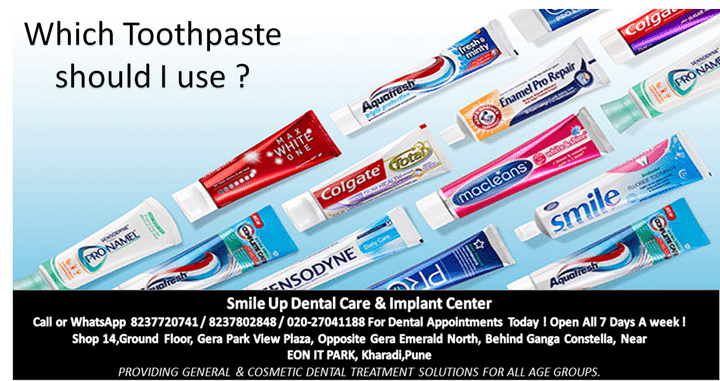Which Toothpaste Should I Use?
Which toothpaste should I use?”
You want to take care of your teeth, just like anyone. Keeping them clean and healthy enhances your smile while saving you money, because when your teeth are in bad shape, you’ll have to spend more correcting them. One of the basic decisions you’ll face in safeguarding your teeth is which toothpaste to use. Each day, the toothpaste you pick will clean your teeth and will have ramifications for years to come. Here’s a guide on what toothpaste you should use.
The Basics
Toothpaste is only a means to an end. If you buy it and then are lazy about brushing your teeth, it won’t help. Indian Dental Association (IDA) recommends brushing your teeth after each meal (and at least once a day). Brushing your teeth removes all the harmful bacteria and plaque that build up when you eat. No matter which toothpaste you choose, it won’t help unless you’re serious about brushing your teeth.
The Science of Brushing Your Teeth
When you’re ready to decide on a brand, you should understand the basic components of each product. Most major brands of toothpaste include abrasive agents. Don’t worry about that label, though. Abrasive agents are usually helpful.
Abrasive agents are the ingredients that cause the scratchy sensation when you brush your teeth. They’re silicates like hydrated silica, calcium carbonate, and hydrated alumina. Some of these materials are the same as sand, which sounds weird, but the ingredients have a purpose. In combination with the brushing movement of your wrist, they’ll scrub away the bacteria and plaque. Conversely, the brushing motion wouldn’t sanitize your teeth without the silicates. Their purpose is to act as a cleaning agent.
The foam on your toothbrush comes from the detergent in the toothpaste. It works similarly to the products you use to clean your dishes and laundry. A detergent breaks down any undesirable substances. With your teeth, it’s loosening materials that aren’t soluble. The liquid in your mouth will dissolve any that is soluble, but you need help with anything that doesn’t respond to liquids.
The Importance of Fluoride
Any good toothpaste will include other components to make it more effective. Fluoride is the most important one. In fact, it’s the primary reason tooth decay and cavities have declined dramatically over the past 50 years. This naturally occurring mineral protects your teeth when you eat. Every food you consume leaves trace elements of sugar and starch on your teeth.
Fluoride counters this problem in two ways. It strengthens tooth enamel, the protective layer on the outside of your teeth, and that added strength makes your teeth less susceptible to chipping and cracking.
When you consume items that stain your teeth such as coffee, cigarettes, wine, tea, and sugary drinks, the enamel weakens. Fluoride counters this issue, although you should still brush your teeth more often if you smoke or consume any of those products. Fluoride also fights off previous damage by reversing the process of tooth decay. For these two reasons, when you shop for toothpaste, you should pick one with fluoride.
Other Toothpaste Components
Many toothpastes will also include artificial sweeteners. The minty taste that you associate with toothpaste isn’t a natural flavor. Manufacturers add saccharin and other ingredients to make the taste of toothpaste better. Without it, the process of brushing your teeth wouldn’t feel as pleasant. If brushing your teeth left you with a bad taste in your mouth, it might reduce your desire to brush regularly. Toothpaste now comes in flavors as diverse as lemon, grape, and bubblegum to make them more appealing – not just for adults, but for children too.
Toothpaste also includes ingredients to keep the tube from drying out. Without the moisture retention of humectants, your mouth would dry too soon. These are the same ingredients that keep you from having dry skin. Finally, toothpaste uses thickeners to make sure that the actual substance maintains a gooey form.
Which Toothpaste Is Best?
Now that you know the key components of toothpaste, you can pick the brand that’s right for you. If you’re a smoker or coffee drinker, you should choose a product with the highest amount of fluoride. Without a prescription, you’re looking for a brand that’s at least 1,000 parts per million (PPM). A product with the IDA Seal has received independent review and validation of its product claims.
If you’re someone with yellow teeth, you’ll want a brand with a higher number of silicates. A product that includes whitening will gradually alter the shade from yellow back to white. If cavities are a big issue, you want a product with special cavity-fighting power. If you have a plaque problem, you can prevent tartar buildup with toothpastes that are specifically formulated to fight tartar. Finally, if you have sensitive gums and/or teeth, the best product is one that treats the underlying problem of sensitivity.
As you can see, toothpaste includes a lot of components specifically designed to protect and improve your teeth. No matter the problem you worry about with your teeth, a product exists that can help you overcome the issue. Simply consider your needs and then mix and match from the options above.



+1.svg)
